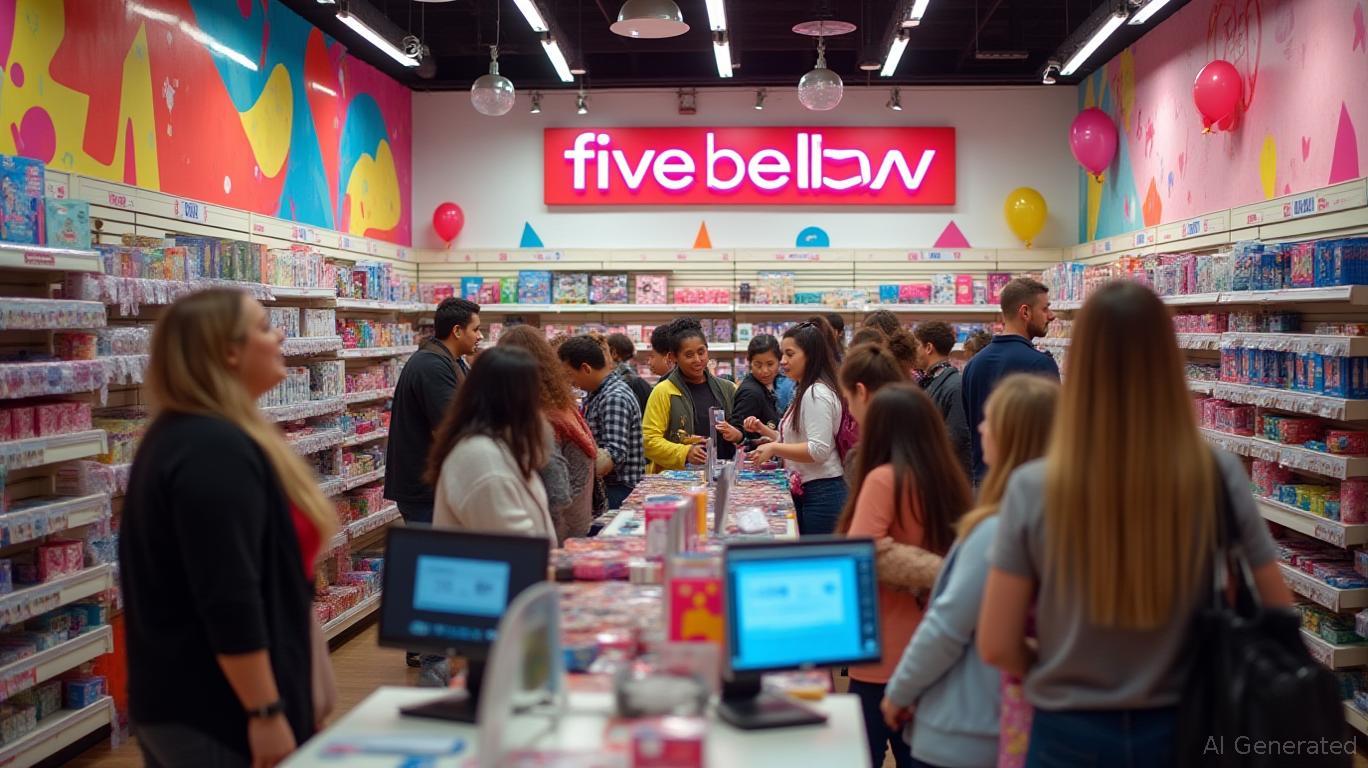Five Below's Q1 2026 Earnings: Navigating Tariff Headwinds for Long-Term Growth
Five Below (FIVE) delivered another quarter of robust top-line growth, with net sales surging 19.5% year-over-year to $970.5 million in Q1 2026, fueled by a 7.1% rise in comparable sales. Despite margin pressures from tariffs and rising costs, the company's focus on product innovation, inventory discipline, and geographic expansion positions it as a standout in the retail sector. While near-term headwinds remain, the stock's dip post-earnings—driven by cautious guidance—creates a compelling entry point for investors willing to bet on its long-term growth trajectory.

Key Takeaways from Q1 2026 Results:
- Revenue Growth: Exceeded estimates by $38.5 million, driven by transaction growth (up 6.2%) and a broader product mix.
- Margin Challenges: Gross margins contracted by 10 basis points to 33.8%, with operating margins pressured by tariffs and labor investments.
- Tariff Mitigation: Management outlined a multi-pronged strategy to reduce reliance on Chinese imports and stabilize pricing.
- Store Expansion: Plans to open 150–160 new locations in 2026, targeting underserved markets like the Pacific Northwest and rural areas.
Strategic Initiatives: Building Resilience Amid Tariffs
Five Below's ability to sustain momentum despite macroeconomic headwinds hinges on three core strategies:
1. Product Innovation and Assortment Shifts
The company's focus on “trend-right” products—such as beauty tools, tech accessories, and licensed merchandise—has created a flywheel effect of customer engagement. For instance, Easter and spring break items drove strong traffic in Q1, while licensed products like Minecraft and Pokémon merchandise maintained high in-stock positions. Management emphasized a pivot to “everyday essentials” like school supplies and small appliances to reduce reliance on fad-driven demand. This shift not only diversifies revenue streams but also aligns with the Gen Z demographic's preference for practical, affordable items.
2. Inventory Management and Supply Chain Agility
Five Below's inventory per store declined 2% year-over-year, reflecting better demand forecasting and reduced write-downs from past overstock issues. The company plans to accelerate inventory receipts in Q2 to prepare for peak seasons, a move that could mitigate potential stockouts. Additionally, its diversification of suppliers—reducing Chinese sourcing by 10 percentage points for the second half of the fiscal year—highlights proactive risk management. By partnering with vendors in Vietnam and India,
aims to stabilize costs and avoid reliance on any single region.3. Store Expansion and Geographic Diversification
With 1,826 stores as of Q1, Five Below is aggressively targeting 150–160 new locations in 2026, prioritizing underpenetrated markets. New stores in regions like the Pacific Northwest and rural areas are performing strongly, with grand openings in Victorville, CA, and Joplin, MO, among the top performers. This geographic expansion not only drives incremental revenue but also reduces competition overlap with existing stores, ensuring scalability.
Navigating Tariff Pressures: A Long-Term Play
While tariffs are projected to reduce margins by ~150 basis points in 2026, Five Below's mitigation strategies—such as vendor diversification, selective price adjustments, and operational efficiencies—suggest a path to stabilization. Management noted that 15% of its product catalog is being tested for price increases, while 80% remain at $5 or under, preserving its value proposition. Additionally, fixed-cost leverage from scale and lower SG&A expenses (down 10 basis points to 23.3% of sales) provide a buffer against margin pressures.
Risks and Near-Term Concerns
- Tariff Volatility: Unilateral trade policies or geopolitical shifts could disrupt supply chains, despite current mitigation efforts.
- Consumer Spending: A potential slowdown in discretionary spending could pressure transaction growth, though Five Below's $5 price point offers recession resilience.
- Inventory Risks: Accelerated inventory buildup in Q2 may lead to write-downs if demand softens, though management claims current levels are “strategically positioned.”
Investment Thesis: A Contrarian Opportunity
Despite the stock's post-earnings dip (down 0.9%), Five Below remains a compelling buy for investors focused on long-term retail resilience. Key positives include:
- Strong Unit Economics: A 19.5% revenue CAGR over the past five years, with ~$5 million annual sales per store.
- Balance Sheet Strength: $624 million in cash, zero debt, and a history of disciplined capital allocation.
- Execution Excellence: Management's track record in navigating past challenges (e.g., pandemic disruptions) bodes well for current hurdles.
Analysts at UBS and Telsey Advisory Group have raised price targets to $160 and $128, respectively, citing Five Below's shift from a “novelty retailer” to a Gen Z-focused discount department store. While near-term margin pressures may limit upside, the stock's current valuation—trading at 24x 2026 EPS estimates—appears reasonable given its growth profile.
Final Analysis: Buy the Dip
Five Below's Q1 results reaffirm its ability to execute in a tough environment, with strong comps and store-level metrics signaling durable demand. While tariffs and inflation pose short-term risks, the company's strategic initiatives—product diversification, geographic expansion, and supply chain agility—are building a moat for long-term growth. Investors should view dips below $120 as opportunistic entry points, with a target of $130–$140 by fiscal year-end. For those willing to look past near-term noise, Five Below remains a retail stalwart worth owning.

Comments
No comments yet